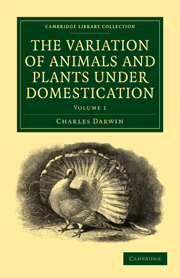Book contents
- Frontmatter
- Contents
- LIST OF ILLUSTRATIONS
- INTRODUCTION
- CHAPTER I DOMESTIC DOGS AND CATS
- CHAPTER II HORSES AND ASSES
- CHAPTER III PIGS — CATTLE — SHEEP — GOATS
- CHAPTER IV DOMESTIC RABBITS
- CHAPTER V DOMESTIC PIGEONS
- CHAPTER VI PIGEONS—continued
- CHAPTER VII FOWLS
- CHAPTER VIII DUCKS — GOOSE — PEACOCK — TURKEY — GUINEA-FOWL — CANARY-BIRD — GOLD-FISH — HIVE-BEES—SILK-MOTHS
- CHAPTER IX CULTIVATED PLANTS: CEREAL AND CULINARY PLANTS
- CHAPTER X PLANTS continued — FRUITS — ORNAMENTAL TREES — FLOWERS
- CHAPTER XI ON BUD-VARIATION, AND ON CERTAIN ANOMALOUS MODES OF REPRODUCTION AND VARIATION
CHAPTER II - HORSES AND ASSES
Published online by Cambridge University Press: 05 October 2010
- Frontmatter
- Contents
- LIST OF ILLUSTRATIONS
- INTRODUCTION
- CHAPTER I DOMESTIC DOGS AND CATS
- CHAPTER II HORSES AND ASSES
- CHAPTER III PIGS — CATTLE — SHEEP — GOATS
- CHAPTER IV DOMESTIC RABBITS
- CHAPTER V DOMESTIC PIGEONS
- CHAPTER VI PIGEONS—continued
- CHAPTER VII FOWLS
- CHAPTER VIII DUCKS — GOOSE — PEACOCK — TURKEY — GUINEA-FOWL — CANARY-BIRD — GOLD-FISH — HIVE-BEES—SILK-MOTHS
- CHAPTER IX CULTIVATED PLANTS: CEREAL AND CULINARY PLANTS
- CHAPTER X PLANTS continued — FRUITS — ORNAMENTAL TREES — FLOWERS
- CHAPTER XI ON BUD-VARIATION, AND ON CERTAIN ANOMALOUS MODES OF REPRODUCTION AND VARIATION
Summary
The history of the Horse is lost in antiquity. Remains of this animal in a domesticated condition have been found in the Swiss lake-dwellings, belonging to the latter part of the Stone period. At the present time the number of breeds is great, as may be seen by consulting any treatise on the Horse. Looking only to the native ponies of Great Britain, those of the Shetland Isles, Wales, the New Forest, and Devonshire are distinguishable; and so it is with each separate island in the great Malay archipelago. Some of the breeds present great differences in size, shape of ears, length of mane, proportions of the body, form of the withers and hind quarters, and especially in the head. Compare the race-horse, dray-horse, and a Shetland pony in size, configuration, and disposition; and see how much greater the difference is than between the six or seven other living species of the genus Equus.
Of individual variations not known to characterise particular breeds, and not great or injurious enough to be called monstrosities, I have not collected many cases. Mr. G. Brown, of the Cirencester Agricultural College, who has particularly attended to the dentition of our domestic animals, writes to me that he has “several times noticed eight permanent incisors instead of six in the jaw.” Male horses alone properly have canines, but they are occasionally found in the mare, though of small size.
- Type
- Chapter
- Information
- The Variation of Animals and Plants under Domestication , pp. 49 - 64Publisher: Cambridge University PressPrint publication year: 2010First published in: 1868



